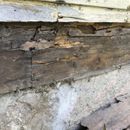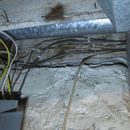Adding exterior insulation to 100 yr old house – added risk for rot where framing contacts foundation?
Going to add exterior insulation (spray foam likely) over 1 layer of siding. The house has a rubble foundation with no capillary break between the foundation and the framing. The ends of the floor joists are embedded in the foundation.
The house had 2 layers of siding. I’ve removed the outer layer to expose the inner and found the inner siding and sheathing rotted at the bottom of the wall where it covered the band joist and sill. See pictures. Luckily, the joist itself is in good shape.
I’m concerned that the added external insulation will compromise the drying potential of the framing that’s in contact with the foundation. Adding a capillary break is not feasible. Is drying to the interior going to be enough? What if we later insulate the basement; special approach for the area of the floor joists?
Basement is currently uninsulated and moderately heated (forced air furnace in basement has 1 duct for the basement.
We are considering excavating the perimeter of the foundation per Joe Lstiburek’s article:
https://buildingscience.com/documents/insights/bsi-045-double-rubble-toil-trouble
Seems this is the best defense – keep the basement walls as dry as possible. Any other opportunities/options we should consider?
GBA Detail Library
A collection of one thousand construction details organized by climate and house part














Replies
Tim,
I wouldn't depend on advice received on a web forum for these details. You can always get more information from a site visit than from a handful of photos.
Do you know what caused the rot? Was it splashback? If so, perhaps the grade is too high, or sloped the wrong direction.
Adding spray foam to the exterior of your siding is possible but unusual. Do you plan to install vertical furring strips or studs on stand-offs before installing the spray foam?
The capillary draw of most field stone is orders of magnitude lower than poured concrete or CMU, so it's unlikely that the rot is from capillary draw. The rot appears to be worse at the top of the exposed layer of siding/sheathing than where it's resting on the stone & mortar, and it all looks pretty good from the interior side. It seems more likely that the rot was from bulk water getting behind the outer layer of siding, perhaps due to unflashed or improperly flashed windows(?), or minimal roof overhangs, splash-back, etc, without an adequate drain-plane.
Make sure you have sufficient exterior foam for dew point control on whatever insulation is inside the walls or on the interior side of the band-joist.
Thanks for info on capillary action of field stone; helps explain why there isn't more rot. This basement gets wet periodically fairly consistently. Would expect more issues where lumber rests on or is embedded in foundation.
The grade here is insufficient as well. Being north side; ground stays wet longer after rain and no direct sunshine.
I'm aware of the dewpoint concern and current plan for SPF is 3" and will have vertical furring strips for later siding attachment. Note: there are 2 layers of siding and we are removing the outer only. The inner layer has lead paint and we don't want to mess with it. So far, it seems to be in pretty good condition.
On the subject of SPF and the foundation, should we fully enclose the band joist area and mud sill in SPF - wrapping the SPF around the bottom of the framing/siding and terminating against the rubble foundation? I envision adding a horizontal non-structural thin piece of wood below the mud sill to form the bottom wall of a cavity for the SPF to fill. Would protect the rubble foundation from overspray from this point down.
I can help explain the exterior rot - many years ago, for about 20 years, our family ran a small evergreen business and in the spring and fall, would set the to-be-replanted 4 to 6 ft evergreens against this north side of the house to keep them in the shade and water them daily to keep the root ball wet. I'm sure we sprayed the house as well. The layer of tar paper behind the siding should have shed the water.
I've removed the outer siding from one other location, east side of the house, next to a field stone chimney. This bottom board of the siding was also repaired next to the chimney. Picture attached. Will certainly learn more as the outer layer is removed.
Thanks for the input. Much appreciated.
Tim
Tim,
The most important sentence in your latest comment is this one: "This basement gets wet periodically fairly consistently."
I would do everything possible to address moisture entry into your basement before proceeding with insulation. For more information on this issue, see Fixing a Wet Basement.